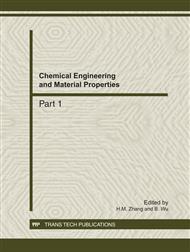p.488
p.493
p.497
p.501
p.505
p.511
p.517
p.524
p.530
Sol-Gel Preparation of Optically Transparent Hydrophobic Hybrid Coating
Abstract:
Optically transparent hydrophobic inorganic-organic hybrid sols was obtained employing Tetraethylorthosilicate (TEOS), Methyltriethoxysilane (MTES), and Heptadecafluoro-1, 1, 2, 2-tetradecyl)trimethoxysilane (FAS), with nitric acid as catalyst. Hybrid coating was dip coated on glass slides. The results showed that the water contact angle of MTES modified SiO2 coating was only 105° . As the weight ratio FAS varied from 0 to 8 wt.%, the water contact angle reached as high as 116.5°. The coated glass presented transmittance of 92%, 2% higher than the non-coated ones. The increase in transmittance suggested an antireflective effect of the hybrid coating. With further SEM characterization of the surface morphology, we finally obtained the optimized optically transparent hydrophobic hybrid coating with the MTES/TEOS_as 1/1(molar ratio) and FAS as 2 wt.%.
Info:
Periodical:
Pages:
505-510
Citation:
Online since:
December 2011
Keywords:
Price:
Сopyright:
© 2012 Trans Tech Publications Ltd. All Rights Reserved
Share:
Citation:


